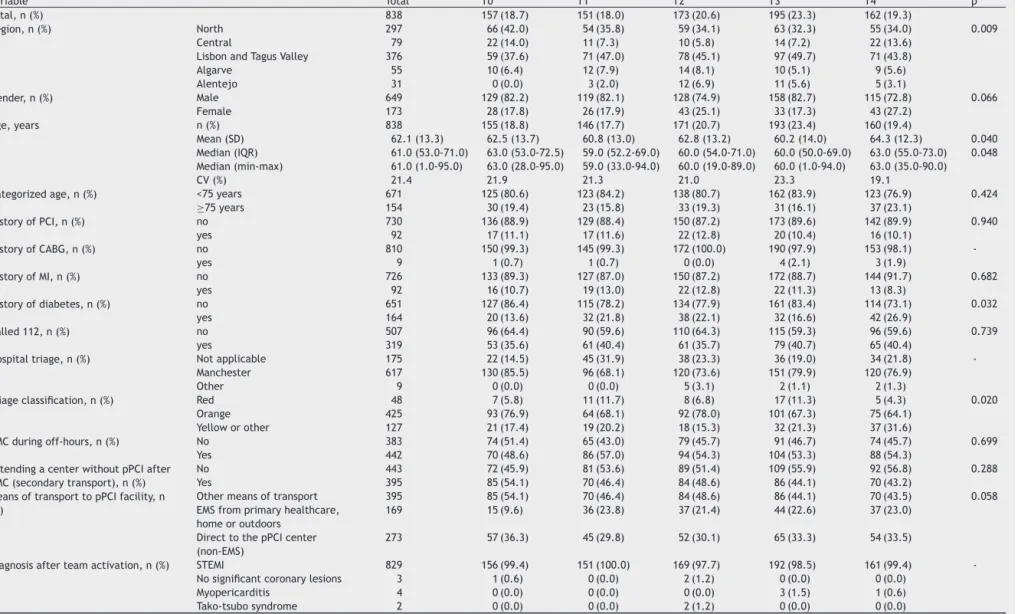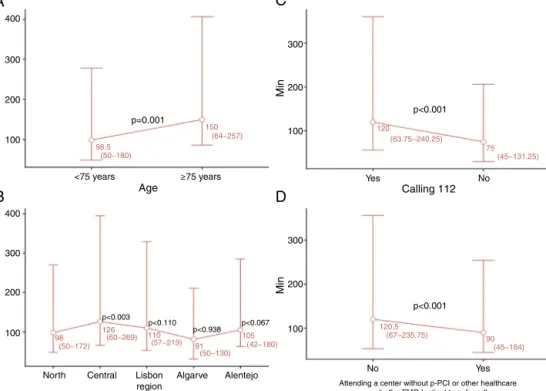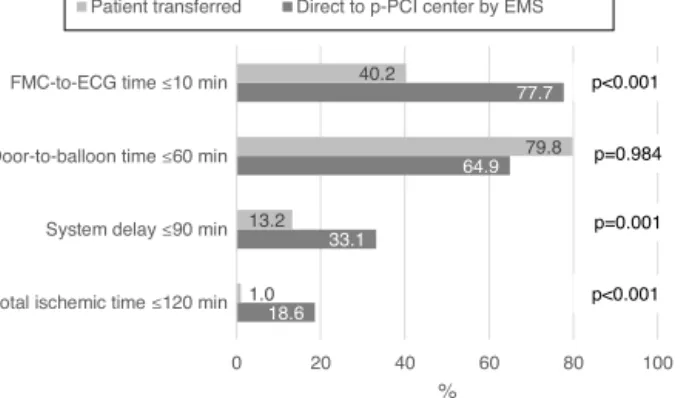RevPortCardiol.2018;37(8):681---690
www.revportcardiol.org
Revista
Portuguesa
de
Cardiologia
Portuguese
Journal
of
Cardiology
ORIGINAL
ARTICLE
The
Stent
for
Life
initiative:
Factors
predicting
system
delay
in
patients
with
ST-segment
elevation
myocardial
infarction
Hélder
Pereira
a,∗,
Fausto
J.
Pinto
b,
Rita
Calé
a,
Ernesto
Pereira
a,
Sofia
Mello
c,
Sílvia
Vitorino
a,
Pedro
Jerónimo
de
Sousa
a,f,
Bruno
Brochado
d,
Sílvia
Monteiro
e,
Rui
Campante
Teles
f,
on
behalf
of
the
centers
participating
in
the
Stent
for
Life
Initiative
Portugal
aCardiologyDepartment,HospitalGarciadeOrta,Almada,Portugal
bCardiologyDepartment,CCUL,CAML,UniversityofLisbon,Lisbon,Portugal cSFLProjectManager,Lisbon,Portugal
dCardiologyDepartment,CentroHospitalardoPorto,Porto,Portugal
eCardiologyDepartment,CentroHospitalareUniversitáriodeCoimbra,Coimbra,Portugal fCardiologyDepartment,CentroHospitalardeLisboaOcidental,Lisbon,Portugal
Received12February2017;accepted10January2018 Availableonline23July2018
KEYWORDS Predictivefactors; Systemdelay; ST-segmentelevation myocardial infarction;
StentforLife
Abstract
IntroductionandAims:System delay (time between first medical contact and reperfusion therapy) isanindicator ofquality ofprimary percutaneouscoronary intervention (pPCI)in ST-segmentelevationmyocardialinfarction(STEMI)patients.Thisstudyaimedtoassesschanges insystemdelaybetween2011and2015,andtoidentifyitspredictors.
Methods:Thestudyincluded838patientsadmittedto18Portugueseinterventionalcardiology centers suspectedofhavingSTEMIwithlessthan12 hours’ durationwho werereferred for primarypercutaneouscoronaryintervention.Datawerecollectedforaone-monthperiodevery yearfrom2011to2015.Univariateandmultivariatelogisticregressionmodelswereusedto determinepredictorsofsystemdelay.
Results:Nosignificantchangesinsystemdelaywereobservedduringthestudy.Only27%of patientshadasystemdelayof≤90min.Multivariateanalysisidentifiedfourpredictorsofsystem delay:age≥75years(OR2.57;95%CI1.50-4.59;p=0.001),attendingacenterwithoutpPCI(OR 4.08;95%CI2.75-6.10;p<0.001),notcallingthenationalmedicalemergencynumber(112)(OR 0.47;95%CI0.32-0.68;p<0.001),andCentralregion(OR3.43;95%CI1.60-8.31;p=0.003).
∗Correspondingauthor.
E-mailaddress:hhpereira@gmail.com(H.Pereira).
https://doi.org/10.1016/j.repc.2018.01.011
682 H.Pereiraetal. Conclusions:Thefactorsage≥75years,attendingacenterwithoutpPCI,notcalling112,and Centralregionwereidentifiedaspredictinglongersystemdelay.Thisknowledgemayhelpin planninginterventionstoreducesystemdelayandtoimprovetheclinicaloutcomesofpatients withSTEMI.
©2018SociedadePortuguesadeCardiologia.PublishedbyElsevier Espa˜na, S.L.U.Allrights reserved. PALAVRAS-CHAVE Fatorespreditivos; Atrasodosistema; Enfartedomiocárdio com supradesnivelamento dosegmentoST;
StentforLife
IniciativaStentforLife:fatorespreditivosdeatrasodosistemaemdoentes comenfartedomiocárdiocomsupradesnivelamentodosegmentoST
Resumo
Introduc¸ãoeobjetivos: O«Atraso do Sistema» (tempo decorrido entreo primeiro contacto médico eaterapêuticade reperfusão)tem sidoconsiderado umindicador dequalidadena angioplastiaprimária(P-PCI)emdoentescomenfartedomiocárdiocomsupradesnivelamento dosegmentoST(STEMI).Esteestudotemcomoobjetivoestudaraevoluc¸ãodascaracterísticas doatrasodosistemaentre2011e2015eidentificarosseuspreditores.
Métodos: Oestudo incluiu 838 doentescom suspeitade STEMI commenos de12 horasde evoluc¸ãoepropostosparaangioplastiaprimária,queforamadmitidosem18centros portugue-sesdecardiologiadeintervenc¸ão.Estesdadosforamrecolhidosduranteummêsporano,entre 2011e2015.Modelosderegressãolinearunivariávelemultivariávelforamusadospara iden-tificarosfatorespreditivos doatrasodosistema.Aolongodoestudo,nãoforamobservadas diferenc¸assignificativasnoatrasodosistema.
Resultados: Apenas27%dosdoentesobtiveramumatrasodosistema<90minutos.Aanálise multivariávelencontrouquatro preditores deatraso dosistema:idade≥75 anos(OR2,57; CI95%1,50-4,59;p=0,001),entradanumcentrosemP-PCI(OR4,08;CI95%2,75-6,10;p<0,001), ligar112-EMS(OR0,47;CI95%0,32-0,68;p<0,001)eRegião«Centro»(OR3,43;CI95%1,60-8,31; p=0,003).
Conclusões:Osfatores«idade>75anos»,«entradanumcentrosemP-PCI»,não«ligarparao 112-SEM»e«RegiãoCentro»foramidentificadoscomofatorespreditoresparamaioratrasono sistema.Oconhecimentodestesfatorespermitiráprogramarintervenc¸õesquevisemreduziro atrasodosistemaemelhorarosresultadosdosdoentescomSTEMI.
©2018SociedadePortuguesadeCardiologia.PublicadoporElsevierEspa˜na,S.L.U.Todosos direitosreservados.
CI confidenceinterval
ECG electrocardiogram
EMS emergencymedicalservices
FMC firstmedicalcontact
IQR interquartilerange
MI myocardialinfarction
OR oddsratio
pPCI primarypercutaneouscoronaryintervention
SFL StentforLife
STEMI ST-segmentelevationmyocardialinfarction
Introduction
Primary angioplasty is the best treatment for ST-segment
elevation myocardial infarction (STEMI) patients.1---4
How-ever,eveninthemostdevelopedcountries,withanational hospitalnetworkequippedwithcatheterizationlaboratories
and highly skilled teams working 24/7, primary percu-taneous coronary intervention (pPCI) is rarely achieved within 120min of symptom onset.Efforts therefore need to be made to enable better access to pPCI. For this purpose, it is essentialtoaudit, monitorand assess coro-nary networks. Primary angioplasty should be conducted within 12 hours of symptom onset, but the greatest benefits are achieved if pPCI is performed within two hours.1,2,4,5
Totalischemictime,definedastimefromsymptomonset to reperfusion, is a well-established prognostic factor in STEMIpatients.6-9Itisdividedintotwomainperiods,time
fromsymptomonsettofirstmedicalcontact(FMC)(patient delay),andtimefromFMCtopPCI(systemdelay).4,10
Theguidelinessuggestdoor-to-balloontime(timefrom arrivalatapPCIcentertobeginningofpPCI)asameasureto assessthehospital’sperformancein STEMItreatment.1,4,11
However, other studies have reported that reducing this timedoesnotpositivelyimpactmortality11 andthatdelays
at otherstagesalsoinfluenceinfarct sizeandmortalityin STEMIpatients.12,13
FactorspredictingsystemdelayinSTEMI 683 Studies havereportedthatlongersystem delayis
asso-ciatedwithhigher mortalityandmorbidity rates in STEMI patients.7,14---16
StentforLife(SFL)isaninitiativebytheEuropean Associ-ationofPercutaneousCardiovascularInterventionsandthe European Society of Cardiology designed to improve the treatment of STEMIpatients and to reduce STEMI-related mortality.SFLaimstoincreasethenumberofSTEMIpatients treatedbypPCIincountriesthatjointheinitiativeandto ensurethatcentersareabletoperformpPCI24/7.17
Portu-galhasbeenpartofthisinitiativesince201118andcurrently
18 centers in mainland Portugal performpPCI procedures 24/7.
Variousfactorsinfluencesystemdelay.Importantly, fail-ureto contacttheemergency medicalservices(EMS) and off-hourspresentationleadtolongersystemdelay.19
Inthelastdecade,pPCIratesinPortugalwereamongthe lowestinWesternEurope,thoughinrecentyearsthe pro-cedurehasbeenperformedmorefrequentlyinPortuguese hospitals,suggestingthatthecountry’sparticipationinthe SFLinitiativehashadapositiveimpact.20
Thispaperaimstoassesschangesinsystemdelaysince PortugaljoinedSFL, toidentifyfactorsthatinfluence this time, and to identify areas of intervention designed to improvecareofSTEMIpatients.
Methods
Studydesignanddatacollection
The study population was composed of 838 patients sus-pectedofhavingSTEMIwithlessthan12hours’durationwho werereferredforpPCIandadmittedtooneofthe18 inter-ventionalcardiologycentersinmainlandPortugalthathave 24/7pPCIandparticipateintheNationalRegistryof Inter-ventionalCardiology(RNCI)andthePortugueseRegistryof AcuteCoronarySyndromes(ProACS).ThediagnosisofSTEMI wasconfirmedin90.5%ofcases.
Thestudywasbasedonanationalsurveyinvolvingthese centers under the aegis of the Portuguese Association of InterventionalCardiology (APIC). Foraone-month period, everyyearfrom2011to2015,allpatientswithSTEMIwho underwentcoronaryangiographyat the participating cen-terswereenrolledinthestudy.Thesurveywascarriedout at fivetimepoints:fromMay 9 toJune 8,2011, immedi-atelyafterPortugaljoinedSFL(timezero,T0),andat the same point in 2012 (timeone, T1), 2013 (timetwo, T2), 2014(timethree, T3)and2015(timefour,T4).STEMIwas definedaccordingtotheuniversaldefinitionofmyocardial infarction.21FMCwasdefinedasthetimeofarrivalof
medi-caland/or paramedical stafftoattendthe patientor the timeofarrivalatahospitalforfibrinolysisorpPCI.
PatientswhoreceivedfibrinolytictherapypriortopPCI, presented with in-hospital STEMI, were admitted in the autonomous regions of Madeira and the Azores, had late STEMI presentation (more than 12 hours after symptom onset),or didnotpresent STelevation onthe electrocar-diogram,wereexcludedfromthestudy.
Demographic and clinical data were collected. System delaywasconsideredasacontinuousorcategoricalvariable, in accordance with international guidelines. The cut-offs
usedwere120minfortotalischemictime,90minfor sys-temdelay,60minfordoor-to-balloontimeand10minfor FMC-to-electrocardiogram(ECG)time.
Statisticalanalysis
ThenormalityofdatawasassessedbytheShapiro-Wilktest. Assystemdelay valueswereskewed,theyweredescribed usingmediansandinterquartilerange(IQR)andtestedusing the Mann-Whitney U test and the Kruskal-Wallis test for twoor more independentsamples,respectively. Addition-ally,consideringsystemdelayasacategoricalvariable(≤90 min),numberandpercentagewereusedtosummarizethis variableanddifferencesbetweengroups wereassessedby thechi-squaretestorFisher’sexacttest.
Forcategoricaldata, differencesbetweengroups were assessed by the chi-square test or Fisher’s exact test. For continuous and normally distributed data, differ-ences between two or more groups were assessed by the Student’s t test or ANOVA, respectively. For non-normally distributed data, the Mann-Whitney test or the Kruskal-Wallistestwereused.
Consideringsystem delay asacategorical outcome, its associationwitheach potential predictivefactor wasfirst testedin aunivariatelogistic regressionmodel. Multivari-atelogisticregressionmodelswerethenusedtodetermine variablesindependentlyassociatedwithsystemdelay, con-sidering all significant predictive factors identified in the univariatemodel.Oddsratios(OR)and95%confidence inter-vals(CIs)werereported.Theanalysiswasconductedata5% levelofsignificance.Allstatisticalanalyseswereperformed usingRsoftware,version3.1.0.22
Results
The sample comprised 838 patients who underwent pPCI between 2011 (T0) and 2015 (T4). Patient characteristics overtheyearsaresummarizedinTable1.Inthelastyear (T4),patientsincludedintheanalysiswereolder(p=0.048) andhadahigherprevalenceofdiabetescomparedto pre-viousyears(p=0.032).Althoughthepercentageofpatients whocalledthe national medicalemergencynumber(112) didnotchange,thenumberofpatientsadmittedtoapPCI center through the EMS tended toincrease. By contrast, therewasadownwardtrendintheproportionofpatients transferredfromlocalhospitalswithout pPCIfacilities.Of the319patientswithsuspectedSTEMIwhocalled112,only 169(53%)wereinfacttransportedbytheEMS(Table1).
Consideringonlythepatientstransferred(n=379),there weredifferences betweenthe timepoints in those trans-ferred by EMS from another hospital to the pPCI center (inter-hospitaltransport:21%vs.secondarytransport:79%) (p<0.001).Thepercentageofpatientsusingsecondary trans-portdecreasedthroughoutthesurvey(datanotshown).
Table2
presentsthecharacteristicsofsystemdelay(FMC-to-ECG time,door-to-balloontime,systemdelayandtotalischemic time) for the different time points. No differences were found between the four time points. The percentage of patientswithFMC-to-ECGtime<10min wasless than50% atalltimepoints.Door-to-balloontime<60mindecreased
684 H. P ereira et al.
Table1 Characteristicsofthestudypopulationatthedifferenttimepointsofthesurvey.
Variable Total T0 T1 T2 T3 T4 p
Total,n(%) 838 157(18.7) 151(18.0) 173(20.6) 195(23.3) 162(19.3)
Region,n(%) North 297 66(42.0) 54(35.8) 59(34.1) 63(32.3) 55(34.0) 0.009
Central 79 22(14.0) 11(7.3) 10(5.8) 14(7.2) 22(13.6)
LisbonandTagusValley 376 59(37.6) 71(47.0) 78(45.1) 97(49.7) 71(43.8)
Algarve 55 10(6.4) 12(7.9) 14(8.1) 10(5.1) 9(5.6) Alentejo 31 0(0.0) 3(2.0) 12(6.9) 11(5.6) 5(3.1) Gender,n(%) Male 649 129(82.2) 119(82.1) 128(74.9) 158(82.7) 115(72.8) 0.066 Female 173 28(17.8) 26(17.9) 43(25.1) 33(17.3) 43(27.2) Age,years n(%) 838 155(18.8) 146(17.7) 171(20.7) 193(23.4) 160(19.4) Mean(SD) 62.1(13.3) 62.5(13.7) 60.8(13.0) 62.8(13.2) 60.2(14.0) 64.3(12.3) 0.040 Median(IQR) 61.0(53.0-71.0) 63.0(53.0-72.5) 59.0(52.2-69.0) 60.0(54.0-71.0) 60.0(50.0-69.0) 63.0(55.0-73.0) 0.048 Median(min-max) 61.0(1.0-95.0) 63.0(28.0-95.0) 59.0(33.0-94.0) 60.0(19.0-89.0) 60.0(1.0-94.0) 63.0(35.0-90.0) CV(%) 21.4 21.9 21.3 21.0 23.3 19.1
Categorizedage,n(%) <75years 671 125(80.6) 123(84.2) 138(80.7) 162(83.9) 123(76.9) 0.424 ≥75years 154 30(19.4) 23(15.8) 33(19.3) 31(16.1) 37(23.1) HistoryofPCI,n(%) no 730 136(88.9) 129(88.4) 150(87.2) 173(89.6) 142(89.9) 0.940 yes 92 17(11.1) 17(11.6) 22(12.8) 20(10.4) 16(10.1) HistoryofCABG,n(%) no 810 150(99.3) 145(99.3) 172(100.0) 190(97.9) 153(98.1) -yes 9 1(0.7) 1(0.7) 0(0.0) 4(2.1) 3(1.9) HistoryofMI,n(%) no 726 133(89.3) 127(87.0) 150(87.2) 172(88.7) 144(91.7) 0.682 yes 92 16(10.7) 19(13.0) 22(12.8) 22(11.3) 13(8.3) Historyofdiabetes,n(%) no 651 127(86.4) 115(78.2) 134(77.9) 161(83.4) 114(73.1) 0.032 yes 164 20(13.6) 32(21.8) 38(22.1) 32(16.6) 42(26.9) Called112,n(%) no 507 96(64.4) 90(59.6) 110(64.3) 115(59.3) 96(59.6) 0.739 yes 319 53(35.6) 61(40.4) 61(35.7) 79(40.7) 65(40.4)
Hospitaltriage,n(%) Notapplicable 175 22(14.5) 45(31.9) 38(23.3) 36(19.0) 34(21.8) -Manchester 617 130(85.5) 96(68.1) 120(73.6) 151(79.9) 120(76.9)
Other 9 0(0.0) 0(0.0) 5(3.1) 2(1.1) 2(1.3)
Triageclassification,n(%) Red 48 7(5.8) 11(11.7) 8(6.8) 17(11.3) 5(4.3) 0.020 Orange 425 93(76.9) 64(68.1) 92(78.0) 101(67.3) 75(64.1)
Yelloworother 127 21(17.4) 19(20.2) 18(15.3) 32(21.3) 37(31.6)
FMCduringoff-hours,n(%) No 383 74(51.4) 65(43.0) 79(45.7) 91(46.7) 74(45.7) 0.699 Yes 442 70(48.6) 86(57.0) 94(54.3) 104(53.3) 88(54.3)
AttendingacenterwithoutpPCIafter FMC(secondarytransport),n(%)
No 443 72(45.9) 81(53.6) 89(51.4) 109(55.9) 92(56.8) 0.288
Yes 395 85(54.1) 70(46.4) 84(48.6) 86(44.1) 70(43.2)
MeansoftransporttopPCIfacility,n (%)
Othermeansoftransport 395 85(54.1) 70(46.4) 84(48.6) 86(44.1) 70(43.5) 0.058 EMSfromprimaryhealthcare,
homeoroutdoors
169 15(9.6) 36(23.8) 37(21.4) 44(22.6) 37(23.0)
DirecttothepPCIcenter (non-EMS)
273 57(36.3) 45(29.8) 52(30.1) 65(33.3) 54(33.5)
Diagnosisafterteamactivation,n(%) STEMI 829 156(99.4) 151(100.0) 169(97.7) 192(98.5) 161(99.4) -Nosignificantcoronarylesions 3 1(0.6) 0(0.0) 2(1.2) 0(0.0) 0(0.0)
Myopericarditis 4 0(0.0) 0(0.0) 0(0.0) 3(1.5) 1(0.6) Tako-tsubosyndrome 2 0(0.0) 0(0.0) 2(1.2) 0(0.0) 0(0.0)
p:fordifferencebetweengroupsusinganon-parametricKruskal-Wallistest.
CABG:coronaryarterybypassgrafting;CV:coefficientofvariation;ECG:electrocardiogram;EMS:emergencymedicalservices;FMC:firstmedicalcontact;IQR:interquartilerange;MI:
myocardialinfarction;min-max:minimum-maximum;pPCI:primarypercutaneouscoronaryintervention;SD:standarddeviation;STEMI:ST-segmentelevationmyocardialinfarction;T0:
Factors predicting system delay in STEMI 685
Table2 Characterizationofsystemdelayandothertimesthatinfluencesystemdelayoverthedifferenttimepointsofthesurvey.
Variable Total T0 T1 T2 T3 T4 p Total n(%) 838 157(18.7) 151(18.0) 173(20.6) 195(23.3) 162(19.3) FMC-to-ECGtime, min n(%) 838 131(17.9) 136(18.6) 151(20.7) 170(23.3) 142(19.5) Median(IQR) 13.0(5.2-30.0) 16.0(7.5-39.0) 13.0(5.0-30.0) 12.0(7.0-29.5) 12.5(5.0-29.8) 13.0(5.0-28.8) 0.421 FMC-to-ECGtime ≤10min,n(%) No 418 86(65.6) 80(58.8) 84(55.6) 90(52.9) 78(54.9) 0.225 Yes 312 45(34.4) 56(41.2) 67(44.4) 80(47.1) 64(45.1) Door-to-balloontime, min n(%) 838 156(18.7) 147(17.6) 173(20.8) 195(23.4) 162(19.4) Median(IQR) 55.0(30.0-95.0) 54.0(30.0-96.8) 50.0(33.5-96.0) 57.0(30.0-83.0) 57.0(28.0-101.0) 64.0(30.0-100.0) 0.883 Door-to-balloontime ≤60min,n(%) No 382 68(43.6) 64(43.5) 76(43.9) 91(46.7) 83(51.2) 0.585 Yes 451 88(56.4) 83(56.5) 97(56.1) 104(53.3) 79(48.8)
Systemdelay,min n(%) 838 157(18.7) 151(18.0) 173(20.6) 195(23.3) 162(19.3)
Median(IQR) 124.0(89.0-192.0) 115.0(79.0-179.0) 125.0(92.5-186.0) 115.0(87.0-189.0) 130.0(91.0-217.0) 127.0(92.5-203.8) 0.304 Systemdelay≤90min,
n(%)
no 616 107(68.2) 114(75.5) 122(70.5) 147(75.4) 126(77.8) 0.260
yes 222 50(31.8) 37(24.5) 51(29.5) 48(24.6) 36(22.2)
Totalischemictime, min
n(%) 838 157(19.0) 150(18.1) 172(20.8) 191(23.1) 158(19.1)
Median(IQR) 250.0(171.0-408.5) 250.0(180.0-421.0) 247.0(165.0-352.0) 260.5(165.0-392.2) 240.0(165.5-430.5) 263.5(179.2-441.0) 0.542 Totalischemictime
≤120min,n(%)
No 758 144(91.7) 132(88.0) 157(91.3) 176(92.1) 149(94.3) 0.393
Yes 70 13(8.3) 18(12.0) 15(8.7) 15(7.9) 9(5.7)
p:fordifferencebetweengroupsusinganon-parametrictest(Kruskal-Wallis).
Door-to-balloontime:timefromarrivalataprimarypercutaneouscoronaryinterventioncentertobeginningofprocedure;ECG:electrocardiogram;FMC:firstmedicalcontact;IQR:
interquartilerange;Systemdelay:timebetweenfirstmedicalcontactandreperfusiontherapy;T0:timezero,2011;T1:timeone,2012;T2:timetwo,2013;T3:timethree,2014;T4:
686 H.Pereiraetal.
Table3 Univariateandmultivariatelog-linearregressionanalysisofpredictorsofsystemdelay.
Variable n(%) Univariatemodels Multivariatemodel
OR(95%CI) p ORa(95%CI) pa Timepoint T0 157(18.7) 1 - 1 -T1 151(18.0) 1.44(0.88-2.38) 0.153 1.31(0.69-2.51) 0.410 T2 173(20.6) 1.12(0.70-1.79) 0.641 0.87(0.46-1.63) 0.668 T3 195(23.3) 1.43(0.90-2.29) 0.133 1.32(0.71-2.44) 0.380 T4 162(19.3) 1.70(1.03-2.82) 0.040 1.50(0.79-2.87) 0.215 Gender Male 649(79.0) 1 - 1 -Female 173(21.0) 1.73(1.15-2.67) 0.011 1.40(0.88-2.29) 0.162
Categorizedage <75years 671(81.3) 1 - 1
-≥75years 154(18.7) 2.95(1.82-5.05) <0.001 2.57(1.50-4.59) 0.001 Region North 297(35.4) 1 - 1 -Central 79(9.4) 3.22(1.62-7.18) 0.002 3.43(1.60-8.31) 0.003 Lisbonand TagusValley 376(44.9) 1.07(0.76-1.50) 0.697 1.38(0.93-2.05) 0.110 Algarve 55(6.6) 0.93(0.50-1.76) 0.809 0.97(0.47-2.09) 0.938 Alentejo 31(3.7) 3.87(1.33-16.46) 0.029 3.34(1.05-15.01) 0.067 HistoryofPCI No 730(88.8) 1 -Yes 92(11.2) 0.76(0.48-1.24) 0.262 HistoryofMI No 726(88.8) 1 -Yes 92(11.2) 0.79(0.50-1.29) 0.338 Historyofdiabetes No 651(79.9) 1 -Yes 164(20.1) 0.98(0.67-1.45) 0.916 Called112 no 507(61.4) 1 - 1 -yes 319(38.6) 0.59(0.43-0.81) 0.001 0.47(0.32-0.68)<0.001
Arrivalbyownmeansof transportatapPCIcenter
No 221(62.6) 1 - (a)
Yes 132(37.4) 0.56(0.35-0.89) 0.013
FMCduringoff-hours No 383(46.4) 1
-Yes 442(53.6) 1.31(0.96-1.79) 0.088
AttendingacenterwithoutpPCIor otherhealthcareunitafterFMC (patienttransferred)
No 295(39.6) 1 - 1
-Yes 450(60.4) 3.35(2.41-4.69) <0.001 4.08(2.75-6.10)<0.001
DiagnosisofSTEMIafterteam activation
No 9(1.1) 1
-Yes 829(98.9) 0.35(0.02-1.90) 0.318
aAdjustedforalltheothercovariatespresentedinthemultivariatemodel.
CI:confidenceinterval;FMC:firstmedicalcontact;MI:myocardialinfarction;OR:oddsratio;PCI:percutaneouscoronaryintervention; pPCI:primarypercutaneouscoronaryintervention;T0:timezero,2011;T1:timeone,2012;T2:timetwo,2013;T3:timethree,2014; T4:timefour,2015.
Onlysignificantvariableswereincludedinthemultivariatemodel(exceptvariableswithproblemsofmulticollinearity).Thevariable historyofcoronaryarterybypassgraftingwasnotincludedbecausethesmallnumberofcases.
non-significantly from 56.4% to 48.8%. Two hundred and twenty-twopatients (26%)hadasystem delayof ≤90min andonly70patients (8%)hadtotalischemictimeof≤120 min.
Toidentifypotentialfactorspredictingsystemdelay, uni-variate and multivariate logistic regression models were usedtoanalyzeasetofvariablesthatcouldinfluencethe outcome (Table 3). The variables T4, female gender, age ≥75 years,Central and Alentejo regions, not calling112, notarrivingbytheirownmeansoftransporttoapPCIunit, andattendingacenterwithoutpPCIorotherhealthcareunit afterFMC(patienttransferred)wereidentifiedaspotential factorspredicting longer system delay in univariate logis-ticregressionanalysis(Table3).Admissionduringoff-hours periods(nightsorweekends)wasnotsignificantlyassociated withlongersystemdelay.Inmultivariatelogisticregression
analysis,onlyage≥75years,Centralregion,notcalling112 andattendingacenterwithoutpPCIremainedstatistically significant predictors of longersystem delay.Medians and interquartilerangeofsystemdelayarepresentedinFigure1 foreachcategoryofthesepredictivefactorswithp-values frommultivariatelogisticregression.
Figure2Ashows thattherewerenosignificant changes in the number of patients calling 112 over the different timepointsofthesurvey(T0-T4)(p=0.739).Whenstratified accordingtowhetherornotpatientscalled112(Figure2B), differencesbetweenthegroupswerefoundforFMC-to-ECG time(p<0.001),systemdelay (p=0.001)andtotalischemic time(p<0.001). Itcanalsobeseen that32.9%of patients calling112hadasystemdelay≤90min,whichissignificantly more thanthose whodidnot (22.5%).Similarly, consider-ing as a variable whether the patient was transferred or
FactorspredictingsystemdelayinSTEMI 687 400 300 300 200 200 100 100 Min Min Min Min <75 years ≥75 years Age p=0.001 p<0.001 p<0.001 98.5 150 120 75 (50−180) (63.75−240.25) (45−131.25) 98 126 110 81 105 (50−172) (60−269) (57−219) (50−130) (67−235.75) (45−164) (42−180) 120.5 90 (64−257) 400 300 300 200 200 100 100
North Central Lisbon region Algarve Alentejo p<0.003 p<0.110 p<0.938 p<0.067 Yes No Calling 112 No Yes
Attending a center without p-PCI or other healthcare unit after FMC (patient transferred)
A
C
B
D
Figure1 Variablesthatimpactsystemdelay.(A)Age;(B)region;(C)calling112;(D)attendingacenterwithoutpPCIorother healthcareunitafterFMC(patienttransferred).Resultsarepresentedasmediansandinterquartilerange.
Figure2 (A)Changesinnumbersofpatientscallingforthedifferenttimepointsofthesurvey;(B)differencesinsystemdelay betweenpatientswhocalledanddidnotcall112.ECG:electrocardiogram;FMC:firstmedicalcontact;T0:timezero,2011;T1: timeone,2012;T2:timetwo,2013;T3:timethree,2014;T4:timefour,2015.
was taken direct to the pPCI center by the EMS, differ-enceswere found forFMC-to-ECG time,system delay and totalischemictime(Figure3).Itcanbeseenthat33.1%of patientstransporteddirectlytoapPCIcenterbytheEMShad asystemdelay≤90minvs.13.2%ofpatientswhowere trans-ferred(p=0.001),which correspondsto20%morepatients whowerewithintherecommendedsystemdelaytimes.
Discussion
System delay is one of the most important timings for assessing the qualityof a system, but also for determin-ing which reperfusion strategy should be used.23 Current
guidelines suggest pPCI as the ideal reperfusion strategy in STEMI patients, unless it cannot be offered within the
recommended timeframes, in which case fibrinolytic therapyshouldbeconsidered.Thereis,however,still con-siderabledebateconcerninghowmuchdelayisacceptable whenmakingthis decision,or when acombination of the tworeperfusionmethodsshouldbepreferred.24,25Thereis
evidencethatpPCIlosesitsadvantageover fibrinolysisfor longerdelaysaftersymptomonset.26
Our results suggest that there were no significant improvementsinsystemdelaybetweenthebeginningofSFL inPortugal(T0)and2015(T4).Furthermore,thestudy sug-geststhattheaimsstatedinthecurrent STEMItreatment guidelines1,2 have not been achieved in Portugal: system
delaywasover115minatallthetimepointsofthestudy, andonly 33.1%ofSTEMIpatientstransporteddirectly toa pPCIcenterbyEMShadasystemdelayof90minorless.The situationisverydifferentincentralandnorthernEurope.In
688 H.Pereiraetal.
Figure 3 Characterization of system delay according to whetherthepatientwastransferredorwastakendirectlytothe pPCIcenterbytheEMS.ECG:electrocardiogram; EMS: emer-gencymedicalservices;FMC:firstmedicalcontact.
dailypracticeintheNetherlands,almostallSTEMIpatients canbetransportedtoapPCIcenterwithin60minof FMC (whichisusuallytheemergencycall),27whileinSwedenthe
medianFMC-pPCItimeis70min.28
Univariateanalysisofourresultsrevealedthatsixfactors influencesystemdelay:age≥75years,femalegender, Cen-tralandAlentejo regions,and attendingacenter without pPCIwereassociatedwithlongersystemdelay,whereasthe variablescalling112andarrivalbytheirownmeansof trans-portatapPCIcenterwereassociatedwithshortersystem delay.However, themultivariate model showed that only thevariablesage≥75years,Centralregion,andattendinga centerwithoutpPCIwerepredictorsoflongersystemdelay, whereascalling112waspredictiveofshortersystemdelay. In viewof these results,it is important tolook at the wayelderlypatientsarehandledwhentheyenterthehealth system. This segment of the population presents specific characteristics that contribute to greater system delay. Lowliteracy levels,slowness andfrailty affecthowthese patientsarehandledandtransportedinandbetween hospi-tals,leadingtofurtherdelays.
The Central regionpresents significantlylonger system delaysthanotherregionsofthecountry.Oneofthereasons forthis resultmaybethe greaterdistances inthis region betweenthepatient’slocationatthetimeofsymptomonset andthepPCIcenter.Geographicadjustmentsin theSTEMI network and improvements in transport (direct toa pPCI centerandtransfer)mayleadtomoreequitableaccessto pPCI.
Thefactthatthereweremorepatientswhocalled112 withsystem delay ≤90 min than those who did not may haveasimple explanation:in theformergroup,the num-ber of patients who arrive directly at a pPCI center and who spend no time in inter-hospital transfer is likely to be muchhigher. The fact that in our study patients who called 112 had significantly shorter system delay may be closelyrelatedtotheSFLinitiativeinPortugal,assincethe beginningofthisinitiative,theEMSstartedtocontactpPCI centersdirectly,totransmitECGswirelessly,andtodeliver STEMIpatientsdirectlytocatheterizationlaboratories.This isconfirmed bythefactthat, inthisstudy,morepatients transportedbytheEMShadanFMC-to-ECGtimeof≤10min thanthosenottransferredbytheEMS.Arecentstudyinthe
USAdemonstratedthatprehospitalwireless electrocardio-gram transmission reduced system delay.29 In Denmark, a
study conducted between1999 and 2009 investigatedthe impact of a gradual introduction of field triage for pPCI and associated outcomes. Among patients transported by theEMS fromthescene ofthe event,theproportionwho weretriageddirectlytoapPCIcenterinthefieldincreased from 33%to 72%.30 Currentguidelines confirm the
impor-tanceof fieldtriage, stating that thedelay between FMC anddiagnosisshouldbereducedto10minorless.1
Inourstudy,STEMIpatientswhoinitiallyattendeda cen-terwithoutpPCIhadsignificantlylongersystemdelaythan thosewhoarriveddirectlyatapPCIcenter.Comparisonof thevariables patienttransferred vs.directtopPCIcenter byEMS,astheyrelatetoFMC-to-ECGtime≤10min,system delay≤90min,andtotalischemictime≤120min,suggests thatattendingacenterwithoutpPCIisastrongpredictorof prolonged system delay.Significantlymore patients trans-ported directlytoa pPCIcenterby theEMS hadasystem delayof≤90min.Intheworst-casescenario(patient trans-ferred),prolongeddelayiscloselyrelatedtotimespentin thefirsthospital(door-in-door-out)andwithinter-hospital transfer.Somestudiessuggestthatdoor-in-door-outtimeis associatedwithpatientmanagementintheemergencyroom ofthenon-pPCIhospital.16,31
AlthoughinformationcampaignstoraiseawarenessofMI have been conducted,many patients stilldo notcall the EMSandarrive atthehospitalbytheirownmeans.5
How-ever,insomecasesadmissiontoacenterwithoutpPCImay bethroughtheEMS.Thisdoesnotalwaysimplyasystem fail-ure;onestudysuggestedthatthesedelaysareoftendueto diagnosticuncertainty instead.Ofpatientswithsuspected STEMIwhocalled112,only53%wereinfacttransportedby an EMSambulance.In theothercases,thenational refer-ralcenterfor emergencypatients(CODU)didnotactivate EMStransportationfortwomainreasons:therewerenoEMS vehicles available, or the patients were misdiagnosed. In bothcases,thepatientsweretransportedbythefire depart-mentandnotbyEMSambulance,asshouldhaveoccurred. In aCanadian study,patients requiring pPCIand undergo-inginter-hospital transferhadlongersymptom-call times, lowerECGST-elevationscores,andmoreprotocol-negative ECGsatpresentation.32
Regardingtransferredpatients,ourresultssuggesta pos-itivetrend,withasignificantdecreasebeingobservedover thecourseofthestudy.Nevertheless,therearesomeactions that can still be implemented to improve the outcomes of transferred patients, as suggested in a five-year study in the USA, in which a program of rapid triage, transfer, and treatment of STEMI patients implemented in a rural areareducedin-hospitalmortalityandproducedprogressive improvementsindoor-to-balloontime.33
Raising public awareness, including strengthening and improvingcampaignstopublicizetheonsetofMIsymptoms andtoencouragepeopletocallthe112emergencynumber, couldhelpreducesystemdelay.
Our results indicate that system id not decrease over the course of the SFL initiative, but this does not mean thattheinitiative wasunsuccessful. Overlittlemorethan a decade, the use of pPCI tripled in Portugal.34 The
first centers toperform pPCI were located in the largest urban centers, which were providedwith more than one
FactorspredictingsystemdelayinSTEMI 689 angiographyroom.Intheseurbancenters,secondary
trans-port was practicallynon-existent and few patients called 112. Thus, system delay was estimated on the basis of door-to-balloon time only. The spread of pPCI to periph-eralcentersandmorefrequent112callsledtoanincrease insystem delay,mainlydue toincreaseduseofsecondary transport. At the same time, primary transport by EMS alsoincreased,whichalsoincreasedsystemdelay.Infact, althoughthesystem hasbecomemoreefficient,theclock nowstartstickingassoonasFMCoccurs,beforearrivalat thehospital.
Intheintermediatestageofsuchaninitiative,whilethe systemisstilladaptingandexpanding,conventionalquality indicators such as patient delay, system delay and door-to-balloontimearenotsufficientlysensitivetoassesshow the initiative is developing. The percentages of patients whocall 112, who godirectly tosecondary hospitals and who are transported by EMS may be more sensitive and earlier indicators that can be usedto measure a positive evolution.
Ourstudyhassomelimitations.Datawereonlycollected onpatientstreatedbypPCI,sotheycannotbegeneralized toallSTEMIpatients.Inaddition,thesurveyonlycovered onemonthin eachyear,which meansthepossible effects of seasonal factors on the results were not addressed. For this reason, future surveys should collect data continuously.
In conclusion, thisstudy showedthat system delay did notchangesignificantlyduringthestudy period.However, it revealed that thevariables age ≥75 years,attending a centerwithout pPCI,andCentral regionweresignificantly associatedwithprolongedsystemdelay,whereascalling112 wasclearlyassociatedwithshortersystemdelay.Basedon thesefactors,objectivemeasures canbetakentoreduce systemdelayandtoimproveclinicaloutcomesinPortuguese STEMIpatients.However,effortstoimproveoutcomeshould notsimplyaddressasinglequalitymeasurementbutshould instead embrace a broader spectrum of procedures in MI care.
CentersparticipatingintheStentforLifeInitiative PortugalundertheaegisofthePortuguese
AssociationofInterventionalCardiology(APIC): HospitalVilaReal(Dr.HenriqueCyrneCarvalhoandPaulino Sousa), Hospital Braga (Dr. João Costa), Hospital S. João (Dr. João Carlos Silva), Hospital Santo António (Dr. Hen-rique Cyrne Carvalho), Centro Hospitalar Vila Nova de Gaia (Dr. Vasco Gama Fernandes), Hospital de Viseu (Dr. JoãoPipa),CentroHospitalardeCoimbra(Dr.MarcoCosta andDr. Vitor Matos), Hospitalde Leiria (Dr.JoãoMorais), Hospital Fernando da Fonseca (Dr. Pedro Farto e Abreu), Hospital de Santa Maria (Dr. Pedro Canas da Silva), Hos-pital Santa Cruz (Dr. Manuel Almeida), Hospital de Santa Marta (Dr. Rui Ferreira), Hospital Curry Cabral (Dr. Luis Morão), Hospital Pulido Valente (Dr. Pedro Cardoso), Hos-pitalGarciadeOrta(Dr.HélderPereira),Hospital Setúbal (Dr. Ricardo Santos); Hospital de Évora (Dr. Lino Patrício and Dr. Renato Fernandes), Hospital de Faro (Dr. Victor Brandão).
Funding
Theauthorsstatethattheyhavenofundingtodeclare.
Conflicts
of
interest
Theauthorshavenoconflictsofinteresttodeclare.
Acknowledgments
Theauthorsgratefullyacknowledgeallcentersthat partici-patedintheStentforLifeInitiativePortugalbetween2011 and2015.
References
1.StegPG,JamesSK,AtarD,etal.ESCGuidelinesforthe manage-mentofacutemyocardialinfarctioninpatientspresentingwith ST-segmentelevation.TheTaskForceonthemanagementof ST-segmentelevationacutemyocardialinfarctionoftheEuropean SocietyofCardiology(ESC).EurHeartJ.2012;33:2569---619. 2.O’Gara PT, Kushner FG,Ascheim DD, et al. 2013 ACCF/AHA
guideline for the management of ST-elevation myocardial infarction: a report of the American College of Cardiology Foundation/AmericanHeartAssociationTaskForceonPractice Guidelines.JAmCollCardiol.2013;61.
3.KeeleyEC,GrinesCL.Primarycoronaryinterventionforacute myocardialinfarction.JAMA.2004;291:736---9.
4.Authors/Task Force members, Windecker S, Kolh P, et al. 2014 ESC/EACTS Guidelines onmyocardial revascularization: the TaskForce onMyocardial Revascularization ofthe Euro-peanSocietyofCardiology(ESC)andtheEuropeanAssociation for Cardio-Thoracic Surgery (EACTS) Developed with the special contribution of the European Association of Percu-taneous Cardiovascular Interventions (EAPCI). Eur Heart J. 2014;35:2541---619.
5.BrayJE, Stub D,Ngu P,et al. Mass mediacampaigns’ influ-enceonprehospitalbehaviorforacutecoronarysyndromes:an evaluationoftheAustralianHeartFoundation’sWarningSigns Campaign.JAmHeartAssoc.2015;4:e001927.
6.DeLucaG,SuryapranataH,ZijlstraF,etal. Symptom-onset-to-balloontimeandmortalityinpatientswithacutemyocardial infarction treatedbyprimaryangioplasty. JAmCollCardiol. 2003;42:991---7.
7.DeLucaG,SuryapranataH,OttervangerJP,etal.Timedelay to treatmentand mortalityin primary angioplastyfor acute myocardialinfarction:everyminuteofdelaycounts. Circula-tion.2004;109:1223---5.
8.McNamaraRL,WangY,HerrinJ,etal.Effectofdoor-to-balloon timeonmortalityinpatientswithST-segmentelevation myocar-dialinfarction.JAmCollCardiol.2006;47:2180---6.
9.NallamothuBK,BradleyEH,KrumholzHM.Timetotreatment inprimarypercutaneouscoronaryintervention.NEnglJMed. 2007;357:1631---8.
10.BatesER,JacobsAK.TimetotreatmentinpatientswithSTEMI. NEnglJMed.2013:889---92.
11.MeneesDS, PetersonED,WangY,etal. Door-to-balloontime andmortalityamongpatientsundergoingprimaryPCI.NEnglJ Med.2013;369:901---9.
12.Denktas AE, Anderson HV, McCarthy J,et al. Total ischemic time: thecorrect focusof attentionfor optimalST-segment elevationmyocardialinfarctioncare.JACC:CardiovascInterv. 2011;4:599---604.
13.DeutschSB,KrivitskyEL.Decreaseddoortoballoontime:better outcomeforthepatient?WorldJCardiovascDis.2015;5:49---52.
690 H.Pereiraetal. 14.TerkelsenCJ,SorensenJT,MaengM,et al.Systemdelayand
mortalityamongpatientswithSTEMItreatedwithprimary per-cutaneouscoronaryintervention.JAMA.2010;304.
15.PostmaS,DambrinkJ-HE,GosselinkATM,etal.Theinfluenceof systemdelayon30-dayandonlong-termmortalityinpatients withanteriorversusnon-anteriorST-segmentelevation myocar-dialinfarction:acohortstudy.OpenHear.2015;2.
16.Rathore SS,Curtis JP, Chen J,et al. Association of door-to-balloontimeandmortalityinpatientsadmittedtohospitalwith STelevationmyocardialinfarction:nationalcohortstudy.BMJ. 2009;338:b1807.
17.WidimskyP,FajadetJ,DanchinN,etal.Stent4Lifetargeting PCIatallwhowillbenefitthemost:ajointprojectbetween EAPCI,Euro-PCREUCOMEDandtheESCWorkingGrouponAcute CardiacCare.EuroIntervention.2009;4:555---7.
18.PereiraH,PintoFJ,CaléR,etal.StentforLifeinPortugal:this initiativeisheretostay.RevPortCardiol.2014;33:363---70. 19.LohJP,SatlerLF,PendyalaLK,etal.Useofemergency
medi-cal servicesexpedites in-hospital care processes in patients presenting with ST-segment elevation myocardial infarction undergoingprimary percutaneouscoronaryintervention. Car-diovascRevascMed.2014;15:219---25.
20.KristensenSD,LautKG,FajadetJ,etal.Reperfusiontherapy forSTelevationacutemyocardialinfarction2010/2011:current statusin37ESCcountries.EurHeartJ.2014;35:1957---70. 21.Jaffe AS. Thirduniversal definition ofmyocardial infarction.
ClinBiochem.2013;46:1---4.
22.RCoreTeam.R:alanguageandenvironmentforstatistical com-puting.Vienna,Austria:RFoundationforStatisticalComputing; 2014.
23.Betriu A, MasottiM. Comparison of mortalityrates inacute myocardialinfarctiontreatedbypercutaneouscoronary inter-ventionversusfibrinolysis.AmJCardiol.2005;95:100---1. 24.Widimsk´yP,BudesinskyT,VoráˇcD,etal.Longdistance
trans-portforprimaryangioplastyvsimmediatethrombolysisinacute myocardialinfarction.Finalresultsoftherandomizednational multicentretrial-PRAGUE-2.EurHeartJ.2003;24:94---104. 25.NielsenPH,MaengM,BuskM,etal.Primaryangioplastyversus
fibrinolysisinacutemyocardialinfarction:long-termfollow-up
intheDanishacutemyocardialinfarction2trial.Circulation. 2010;121:1484---91.
26.PintoDS,FrederickPD,ChakrabartiAK,etal.Benefitof trans-ferring ST-segment-elevation myocardial infarction patients forpercutaneouscoronaryinterventioncomparedwith admin-istration of onsite fibrinolytic declines as delays increase. Circulation.2011;124:2512---21.
27.deBoerM-J,ZijlstraF.STEMItimedelays:aclinicalperspective: editorialcommentonthearticlebyVerweijetal.NethHearJ. 2015;23:415---9.
28.KoulS,AndellP,MartinssonA,etal.Delayfromfirstmedical contacttoprimary PCIandall-causemortality:anationwide studyofpatientswithST-elevationmyocardialinfarction.JAm HeartAssoc.2014;3:1---8.
29.RoswellRO,GreetB,ParikhP,etal.Fromdoor-to-balloontime tocontact-to-devicetime:predictorsofachievingtargettimes inpatientswithST-elevationmyocardialinfarction.Clin Car-diol.2014;37:389---94.
30.TerkelsenCJ,ChristiansenEH,SørensenJT,etal.PrimaryPCI asthepreferredreperfusiontherapyinSTEMI:itisamatterof time.Heart.2009;95:362---9.
31.LambertLJ,BrownKA,BoothroydLJ,etal.Transferofpatients withST-elevationmyocardial infarction for primary percuta-neous coronary intervention: a province-wide evaluation of door-in to door-out delaysat the first hospital. Circulation. 2014;129:2653---60.
32.TarkinJ,MalhotraA,AppsA,etal.Inter-hospitaltransferfor primaryangioplasty:delaysareoftenduetodiagnostic uncer-taintyratherthansystemsfailureanduniversaltimemetrics maynotbeappropriate.EuroIntervention.2015;11:511---7. 33.BlankenshipJC,ScottTD,SkeldingKA,etal.Door-to-balloon
times under 90 min can be routinely achieved for patients transferredforST-segmentelevationmyocardialinfarction per-cutaneouscoronaryinterventioninaruralsetting.JAmColl Cardiol.2011;57:272---9.
34.PereiraH,CampanteTelesR,CostaM,etal.Trendsinprimary angioplastyinPortugalfrom2002to2013accordingtothe Por-tugueseNationalRegistryofInterventionalCardiology.RevPort Cardiol.2016;35:395---404.




